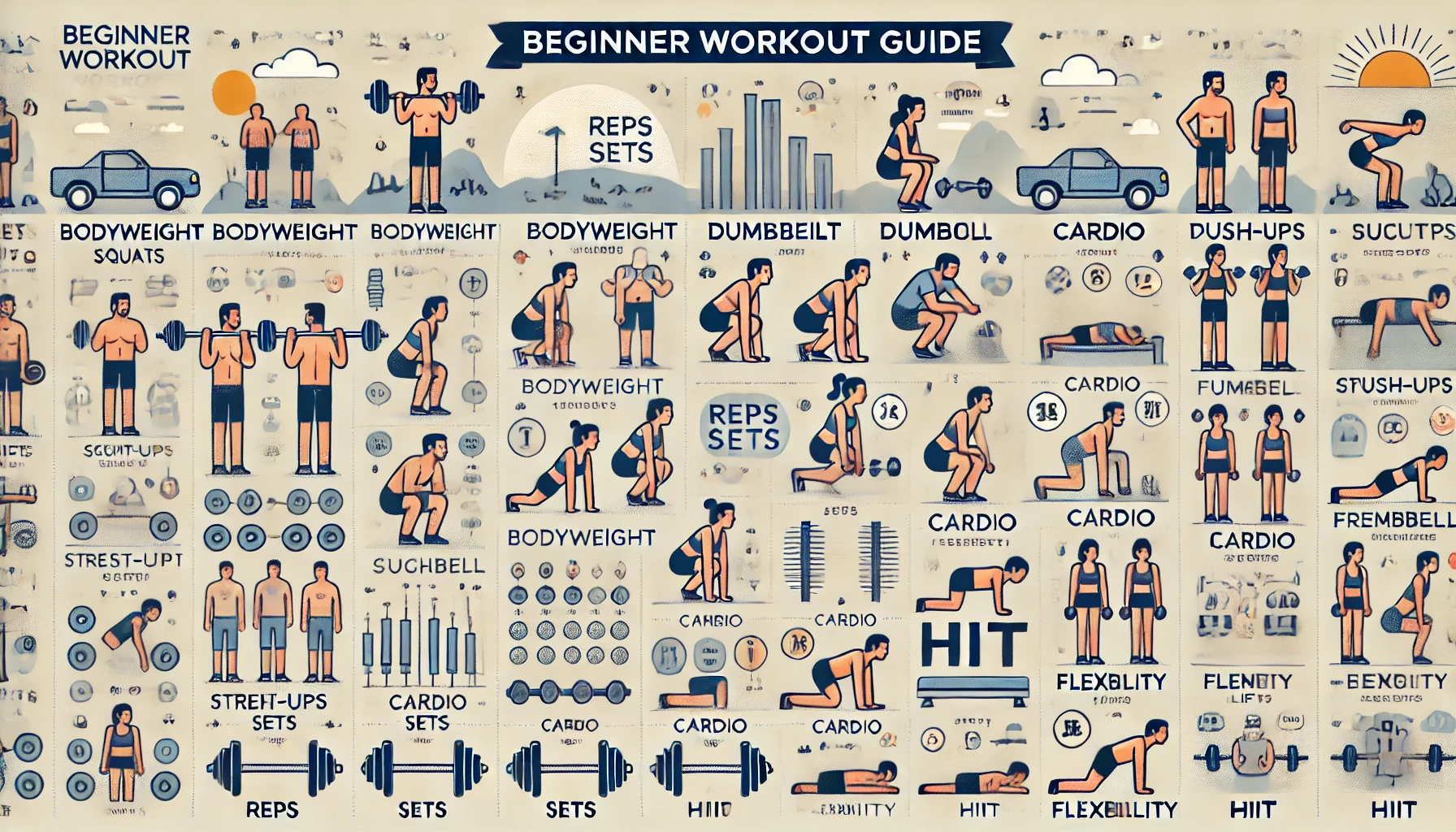
Best Beginner Workout Routines for Building Strength, Cardio, and Flexibility
Starting a workout routine can be overwhelming, but these beginner-friendly workouts will ease you into exercise while effectively targeting key areas: strength, cardio, and flexibility. With minimal equipment and a focus on proper form, these routines will help you establish a safe, balanced fitness foundation.
1. Full-Body Bodyweight Workout
This routine requires no equipment, making it perfect for home workouts. Aim for 3 sets, with 10-15 reps per exercise.
- Squats – Strengthens legs and glutes.
- Push-Ups – Builds chest, shoulders, and arm strength (use knee push-ups if needed).
- Lunges – Works legs and core, enhancing balance.
- Plank – Strengthens core (hold for 20-30 seconds).
- Glute Bridges – Targets glutes and lower back.
Rest 60 seconds between exercises.
2. Dumbbell Routine for Beginners
If you have a pair of dumbbells, this routine is a great way to add resistance training. Perform 10-12 reps for each move, and complete 2-3 sets.
- Dumbbell Bench Press – For chest strength.
- Dumbbell Row – Targets back and shoulder muscles.
- Overhead Press – Strengthens shoulders and upper back.
- Bicep Curl – Builds arm strength.
- Tricep Extension – Tones the back of the arms.
Choose a weight that challenges you but allows proper form.
3. Beginner Cardio Routine
Boost heart health and endurance with low-impact cardio exercises. Perform 3 times a week.
- Brisk Walking – Start with 20-30 minutes.
- Cycling – 15-20 minutes at a moderate pace.
- Jumping Jacks – 3 sets of 30 seconds for full-body warm-up.
Gradually increase time as you build stamina.
4. Flexibility and Mobility Routine
Enhancing flexibility aids in muscle recovery and helps prevent injury. Try these stretches daily.
- Hamstring Stretch – Hold for 30 seconds per leg.
- Quadriceps Stretch – 30 seconds per leg.
- Chest Stretch – 30 seconds.
- Shoulder Stretch – 30 seconds per arm.
- Cat-Cow Stretch – 10 repetitions to improve spine mobility.
Use this as a cool-down after workouts or as a standalone session.
5. Beginner-Friendly HIIT Routine
High-Intensity Interval Training (HIIT) is great for cardio and fat-burning. Complete 30 seconds of each exercise with 30 seconds of rest.
- Jumping Jacks – Great for full-body movement.
- Mountain Climbers – Engages the core and shoulders.
- Bodyweight Squats – Builds leg strength.
- High Knees – Boosts heart rate and core engagement.
Repeat this circuit 2-3 times, resting for 1-2 minutes between rounds.
Additional Tips for Beginners:
- Warm-Up and Cool Down: Warm up with light cardio and end with stretching to aid recovery.
- Rest Days: Incorporate rest days to allow your muscles to recover and prevent injury.
- Stay Consistent: Building a habit is key. Aim to complete 3-4 workouts per week.
- Listen to Your Body: If you feel pain beyond normal muscle soreness, pause and consider professional guidance.
These routines offer a balanced foundation, combining strength, cardio, and flexibility. Starting with manageable workouts and gradually increasing intensity will help you see results without feeling overwhelmed.
Conclusion
Starting a workout routine as a beginner can be both empowering and challenging, but with the right approach, it becomes manageable and rewarding. By incorporating these balanced routines, which focus on bodyweight exercises, cardio, flexibility, and light weightlifting, you’ll develop a strong foundation in fitness, improve overall health, and prevent injuries. Consistency is key, so find a schedule that works for you and stick with it, gradually building intensity as you progress. With dedication and patience, you’ll see both physical and mental benefits over time.
5 Questions and Answers
- What is the best workout routine for a beginner with no equipment?
- A full-body bodyweight routine is ideal for beginners without equipment. Exercises like squats, push-ups, lunges, and planks provide a solid foundation by targeting major muscle groups and building core stability.
- How many days per week should a beginner work out?
- Beginners should aim for 3-4 workout days per week, including both strength and cardio exercises. It’s essential to include rest days between sessions to allow muscles to recover.
- How can I increase the difficulty of my workout routine as I progress?
- You can increase the difficulty by adding more repetitions, using weights, or trying more challenging variations of each exercise. For example, progress from knee push-ups to regular push-ups, or add a pair of dumbbells for squats and lunges.
- What are the benefits of incorporating flexibility exercises?
- Flexibility exercises improve muscle elasticity, increase joint mobility, and aid in recovery, reducing the risk of injury. They also promote relaxation, which can enhance overall performance in other exercises.
- How long should I rest between sets or exercises?
- For most beginner routines, resting 60-90 seconds between sets is sufficient. This allows the muscles time to recover while maintaining your heart rate, which is beneficial for building both strength and endurance.






